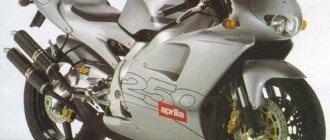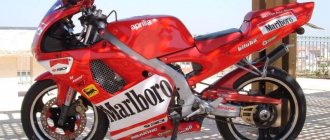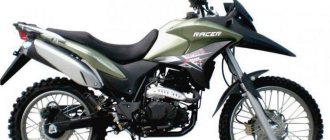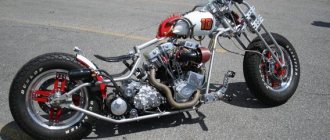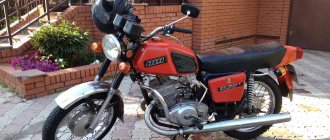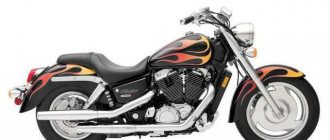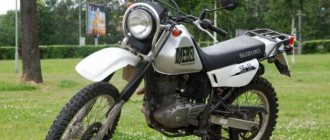Not all Soviet and Russian bikers have heard about the Voskhod 2M motorcycle, although most of them are well acquainted with the products of Kovrov plant named after Degtyarev. The Voskhod series has a long past, starting in the mid-60s and ending in the 2000s, and the old 2M was released in the late 70s, that is, more than forty years ago. This was the third bike in the line, and despite the fact that it lasted only three years on the assembly line, it performed well, paving the way for subsequent models.
Design
The design profession did not exist in the USSR, and stern designers were guided mainly by considerations of practicality. Voskhod 2M was the result of their labors, which is clearly visible from the photo: square, angular, without a hint of any grace, a kind of hard worker, strong, but unprepossessing. However, given the age of the model, now its design does not play a role, since this motorcycle is valuable in itself due to its advanced age.
Are there any disadvantages
But this bike also has several disadvantages. First of all, this concerns the appearance of the model. Looking at the photo of Voskhod 2, it becomes clear that you won’t show off such a vehicle to your friends (unless after styling). In addition, the bike’s frame is a little unsuitable for riding on dirt roads or roads with poor pavement (at the same time, the 2M model does not have this drawback).
Specifications
The hero of our review is simply a slightly modernized version of the previous model, without any fundamental changes. Compared to Voskhod 2, the motorcycle has become a little more powerful, with a modernized suspension, contactless ignition instead of cam and a fresher appearance. For the late 70s, its technical characteristics were quite good.
Engine
The 173.7cc single-cylinder, two-stroke, air-cooled engine dates back to the early 60s. For the Voskhod 2M, the battered engine was slightly upgraded, replacing the cylinder head and redesigning the oil channel layout, which led to an increase in its efficiency. Engine power was 14 hp. (compared to 10.5 hp for its predecessor, the Voskhod 2 motorcycle), and torque is 16 Nm . The maximum speed that a bike with this engine can reach is 105 km/h .
Transmission
a 4-speed gearbox excellent for its time , with a classic 1-N-2-3-4 scheme. From the very beginning of production of the model, improved discs were used in the clutch, making the operation of the box very precise. Moreover, even today, surviving examples that are in good condition demonstrate almost flawless operation of the gearbox.
Chassis and brakes
A standard steel frame made of ferrous metal and simple hydraulic shock absorbers - that’s all that can be said about the chassis of the Voskhod 2M. However, the designers took into account the deplorable state of most Soviet roads, and therefore slightly improved the suspension, increasing the fork travel and its diameter. If you don’t take a passenger on board, the suspension quite confidently absorbs nervousness even on rough rural dirt roads, at least if you don’t accelerate too quickly. And this is definitely not worth doing, given the primitive drum brakes on both wheels.
Electronics
The only noticeable difference between this model and the Voskhod 2 motorcycle was the introduction of contactless ignition. Otherwise, the electronic components did not change, but this bike was already equipped with full-fledged light optics, including turn indicators. The design does not include a battery.
Weight
The dry weight of the bike reaches 119 kg . This is a good 10 kg more than its predecessor, but still a modest figure. Subjectively, Voskhod 2M seems very light, it is easy to roll with your feet if necessary. However, ZiD motorcycles have always been compact and quite light, although they were usually classified as middle class and not light.
Controllability
This motorcycle was created for harsh Soviet conditions, and it handles rough roads confidently. Despite its unprepossessing appearance, Voskhod 2M takes to such situations like a duck to water! But on the highway it clearly lacks directional stability, since due to its low mass and short wheelbase it is noticeably “rearranged” by gusts of side wind.
Fuel consumption
The exact numbers directly depend on the condition of the particular instance. A motorcycle with a properly adjusted carburetor consumes about 4 liters per 100 km when driving on the highway and up to 5-5.5 in the combined cycle with a tank volume of 12 liters .
It is no different in terms of efficiency, just like any other Soviet motorcycle.
Model features
If you look at the photo of the Voskhod motorcycle, we will see a simple workhorse that is great for riding on different road surfaces . The bike's engine is equipped with improved cylinders and modified crankcases. The vehicle body was also slightly modernized.
On the road, the Voskhod motorcycle behaves very reliably and confidently, thanks to which it has earned the status of a reliable iron horse. At the same time, the model maintains its stability even with changes in speed.
Such a vehicle is also pleased with its good dynamics - the maximum speed is reached quite quickly. To accelerate to 60 km/h, the bike takes only 8 seconds
Cool video about a motorcycle from the past Voskhod 2:
Motorcycle price
Due to its prevalence and low demand, you can find this model on the secondary market. The cheapest copies start from 10-15 thousand rubles , but their technical condition usually leaves much to be desired, and there are often no documents. fully serviceable and well-restored bike will cost approximately 100-120 thousand rubles and more.
Repair and tuning
These days, the Voskhod 2M motorcycle is somewhere in the middle between the concepts of “junk” and “rarity”. Therefore, some purchase it as an extremely cheap alternative to small-capacity “Chinese” ones, while others carefully restore their purchase and try to bring it to its original condition. The first approach is simple and cheap, but the second requires significant investments of labor and money.
Repair
Any person with a set of tools and hands growing from the place intended by nature, that is, from the shoulders, can repair the bike on their own. No, seriously - its design is extremely simple, there is practically nothing to break in it, and with proper care, Voskhod 2M can be inherited by great-grandchildren.
Spare parts
Collectors and restorers will encounter difficulties in finding original spare parts, since they will have to search for them long and hard, sometimes shelling out decent amounts of money for used pieces of hardware. But everyone else, who is not fixated on authenticity, will always find a way to attach a cheap Chinese carburetor or some part from a Voskhod of another model.
Tuning
Of course, during restoration to the “original” state, there can be no talk of any tuning. But among those who use the bike for its intended purpose, that is, for riding, the introduction of a battery into the on-board system is very popular. Initially, it was not provided for by the design, but everything can be solved, and besides, this solution allows you to make the operation of the electrical network more stable.
Frequently asked questions
- What about the interchangeability of spare parts from other Voskhods? Everything is fine with the interchangeability of spare parts; many things fit from other ZiD motorcycles. Some units can be picked up even from the latest models, “Owl” and “Courier”.
- Is it possible to install a 6V generator on it? The original is nowhere to be found. The nominal voltage of the standard generator is 7V, but 6V is also most likely suitable.
- Is it possible to find a copy with a side stroller? There are no original strollers for this model and never have been. However, sometimes you can find “collective farm” versions with strollers from “IZh” or “Java” on sale.
Conclusion
There is no point in chasing the 2-M model specifically, unless, of course, you are a rabid collector. Any other “Voskhod” is no worse suited for restoration and even for operation. Restoring a bike to 100% original won't be cheap, but if you repair it with other parts that are more readily available, it can be an inexpensive alternative for riding around the countryside.
Specifications
| Maximum engine power: | 14 HP |
| Working volume: | 173.7 cm3 |
| Motor type (cylinder arrangement, number of strokes): | 1-cylinder, 2-stroke |
| Number of cylinders: | 1 |
| Number of valves: | |
| Intake type (Injector / Carburetor): | |
| Bore and stroke: | |
| Starting system (Electric starter, kick starter): | |
| Maximum speed in km/h: | 105 km/h |
| Cooling system: | Air |
| Transmission (gearbox): | Mechanical 4-speed |
| Clutch (Dry / Wet): | |
| Drive unit: | Chain |
| Frame: | Tubular steel, welded |
| Chassis | |
| Suspension (front/rear travel): | |
| Brakes (Front/Rear): | |
| Wheels / Tires / Rubber: | |
| Dimensions and weight | |
| Dimensions (Length / Width): | |
| Seat height: | |
| Ground clearance: | |
| Curb weight: | |
| Wheelbase: | 1300 mm |
| Weight: | 119 kg |
| Fuel tank capacity: | 12 l. |
| Battery capacity: | |
| Year of release: | |
| Country of Origin: |
“Chekushki” from the Middle Kingdom: Chinese motorcycles 250 cm³
250 cc motorcycles are far from “study desks”, but also not “battering weapons” such as powerful sportbikes or heavy choppers, which require experience and certain physical characteristics to operate.
000_moto_0611_044
Once upon a time, the word “chekushka” was in use - this was the name for a 250-gram bottle of vodka that cost only 1 ruble. 49 kopecks - for one and inexpensive, and without going overboard. Motorcyclists associated the “check” with the Jawa 250 motorcycle - not as expensive as the top model Jawa 350, for which they fought in queues, but no longer an unfinished Soviet product. In general, the “check” meant a budget alternative. Today, perhaps, it’s time to remember the old word: let’s see what kind of “checks” we have from the Middle Kingdom. In our market, the “250” class is represented mainly by Chinese companies that have relatively recently grown into such engines - previously they were producing 125-150-200 cm³ cubic capacity, producing clones of the Honda CG series lower engine. Several types of engines already serve as prototypes for “checks,” and they are much more diverse.
SPORTBIKES
In general, the R 250 can only conditionally be attributed to the Chinese motorcycle industry: the concept belongs to the British company Megelli, the design was created by Italian craftsmen, and only the components are from China. The beauty of the bike, which is not hidden by the fairing, is the birdcage space frame, like on Ducati. The second feature is an openwork pendulum, spied on by another world grandee - Benelli, and it is made of aluminum alloy. The muffler, as has become fashionable, is in the center, protruding from under the passenger side of the seat. There is also no shame in the engine, which is hidden in the depths of the device: it is liquid cooled, produces as many as 26 “horses” and is linked to a six-speed gearbox. The motorcycle sits on 17-inch alloy wheels equipped with petal brake discs. True, there is only one disc at the front, but it has a record diameter of 300 mm for the class.
001_moto_0611_044
The Patron Sport 250 (offered by Ural Motorcycle Company LLC from Izhevsk) in its sportbike guise demonstrates the increased capabilities of the Chinese motorcycle industry. The single-cylinder, four-stroke, air-oil-cooled engine (233 cm³) is equipped with a balancer shaft, an electric starter and is linked to a five-speed gearbox. There are disc brakes on both 17-inch wheels, but the suspension settings are not the best.
002_moto_0611_044
The veteran of our market - Zongshen Winner ZS250GS - has not lost its attractiveness. On a vehicle equipped with a semi-fairing and clip-ons, the driver takes a characteristic semi-recumbent position, the tachometer is located in the center of the instrument panel. The motor is a single-barrel air vent with an enduronic power curve. The brakes on both wheels are disc, with two discs at the front. The chassis features 17-inch wheels, an inverted fork and a rear suspension with a progressive linkage system (alas, without any adjustments). Among the features worth noting are the fuel level indicator on the dashboard and the absence of any cavities for tools. Starting the engine is only possible with an electric starter. The 17-horsepower engine accelerates the motorcycle to 120 km/h. This device has a good reputation of its Chinese “father” - China Zongshen Motorcycle Group Co., Ltd., one of the largest companies in the world.
